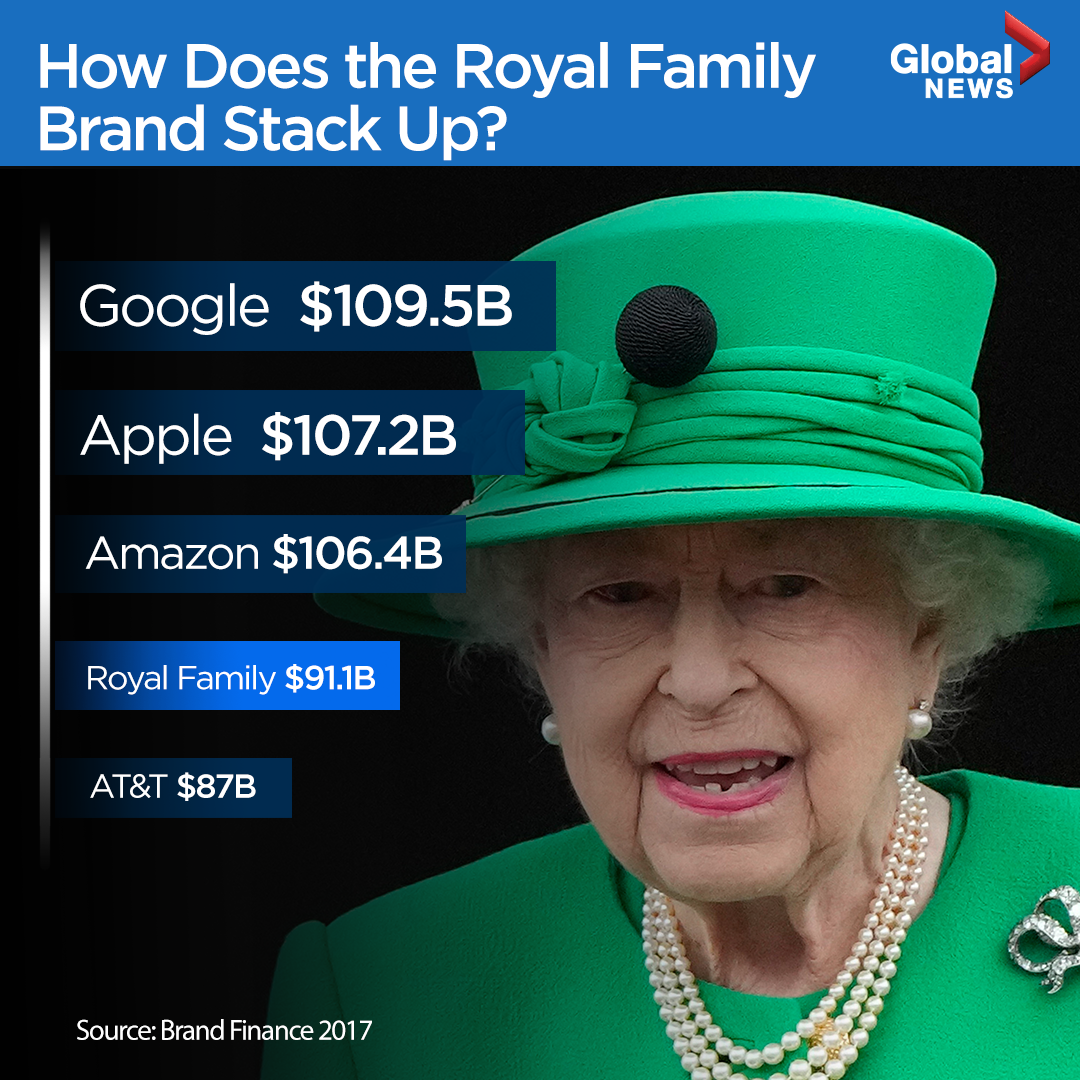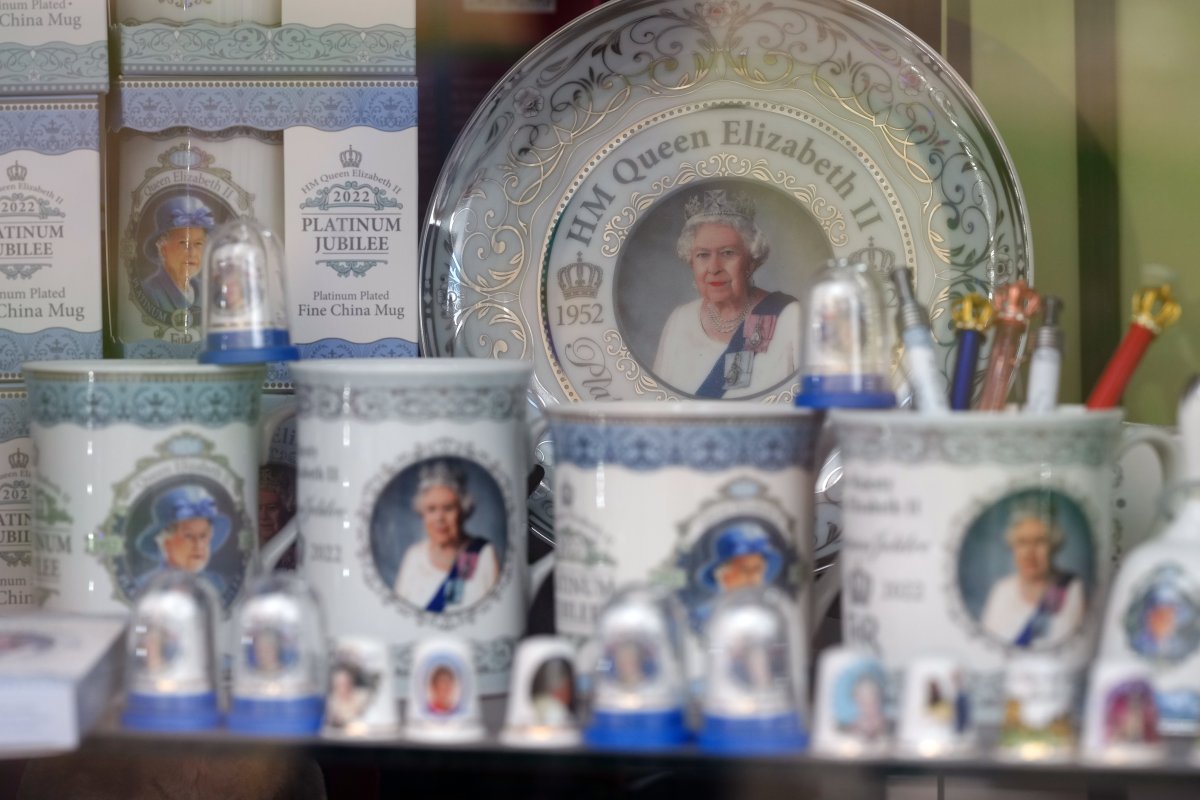The death of Queen Elizabeth II is sure to send shockwaves through the economies of both the United Kingdom and Canada as experts say the brand value of the British royal family is at risk with the loss of its longest-reigning monarch.

The queen’s death on Sept. 8 marked not only the loss of the U.K. and Canada’s constitutional head, but the figurehead and brand ambassador of the monarchy itself, according to Charles Scarlett-Smith, director of Brand Finance Canada.
“When we’re thinking about Queen Elizabeth II’s brand, we really are being synonymous with the royal family and the monarchy,” he tells Global News.
And that brand alone ranks among the most valuable in the world, according to a Brand Finance report assessing the monarchy’s capital value in 2017.
The British monarchy — its actual assets plus intangible impacts on the economy — was valued at £67.5 billion that year, or roughly CAD$112.4 billion in 2017 dollars.
For a rough value comparison, putting the royal family’s impact up to a similar list of major corporate brands prepared that same year by Brand Finance would rank the monarchy fourth in the world, behind just Google, Apple and Amazon.
While the average annual cost for U.K. taxpayers to upkeep the royals comes in around £500 million a year (CAD $700-$750M), Brand Finance estimates the monarchy’s brand contributes £2.5 billion (CAD$3.7B) to the British economy each year.
“Royalist or not, the amount of economic benefit that’s brought to the (U.K.) from the existence of the royal family is undeniable,” Scarlett-Smith says.
Feeding into the economic impact of “The Firm,” as the royal family’s business arm is informally known, is a bit of brand association known as royal warrants, which give corporations the chance to claim the monarch’s seal of approval. Brand Finance claims a royal warrant has led to a 10-per cent boost in revenue on average for the roughly 800 British firms bearing the mark.
Royals drive U.K. tourism
Tourism dollars also play a major role in that economic impact. Brand Finance said in 2017 that it expects the royal family generates some £550 million (CAD$915M) annually for U.K. tourism as travellers include destinations such as Buckingham Palace or the Tower of London on the itineraries.
Lesley Keyter, who grew up in England and now runs The Travel Lady agency in Calgary, says the monarchy’s draw on her Canadian clientele is “huge.”
Most avid travellers who book with her are also big history buffs, Keyter says, which makes pilgrimages to see the Crown Jewels or take in the royals’ palaces impossible to resist.

The queen’s passing this past week will spur even more travel to these iconic landmarks, she argues, as royalists mourn the monarch.
“I must confess, I shed a few tears because she was such a remarkable woman,” Keyter reflects in an interview with Global News.
“I’m sure over the next year there’s going to be a lot of people visiting Buckingham Palace … somewhere where they can leave a flower or a note or something on the gates.”
Much of the credit for the monarchy’s lucrative brand can be placed at the feet of the late queen herself, argues journalist and royals researcher Emily Stedman.
That most people think of her when saying just the words “the queen” was a reflection of one of the oft-quoted lines during her reign, that “you have to be seen to be believed,” she says.
As such, she went on more than 250 royal tours in the 70 years she held the throne, visiting Canada 22 times. These visits were as much a branding exercise as a display of formal duty, Stedman argues.
“She is the face of the British monarchy at the end of the day. When you say the words, ‘the royal family’, she is the first figure that comes to mind,” she says.
It’s her face on the plates and mugs lining every British gift shop in London, Stedman notes.
“It is going to be such a great loss and a big change for people to really factor in that, ‘OK. The queen’s passed and now the head of the royal family is King Charles III.”
Can the royal brand outlive Queen Elizabeth II?
But in the formal transition of power lies the British monarchy’s greatest test yet to come, Scarlett-Smith notes.
While he believes the queen’s image might leave a “legacy” that persists beyond her life — the royal family can make use of her iconography for plays at “history” and “nostalgia” — the value of the brand is now in the hands of King Charles III and the other royals.
“We’ll have to see really how the new custodians of the brand are able to transfer that sheer amount of international goodwill that the Queen had into the new enterprise,” he says.

Canada, too, will have a series of questions to grapple with as it relates to the queen, the constitutional monarchy and the country’s economic future.
On the topic of money, one of the first questions will be Canadians’ comfort levels with having the queen’s face adorning the green $20 bill.
There’s no legal imperative forcing Canada to put King Charles III’s face on the banknote instead of Queen Elizabeth II, notes Stedman, and so it will likely come down to a question of political will.
Older Canadians tend to be more fond of the monarchy than the younger generation, she notes, which could weaken appetite for more royal representation on our bills and in our political systems going forward.
But Scarlett-Smith also notes that there might be an economic incentive on both sides of the pond to maintain Canada’s constitutional monarchy. Trade deals borne out of Canada and the U.K.’s “idea of closeness… of union” might not come together as easily if Canadians opt to formally remove the monarchy as the head of state, he says.
“I think that the idea of a tie, the idea of a bond with the U.K. can go beyond the monarchy,” Scarlett-Smith says.
“Whether that will be reason enough to maintain the relationship will be, I think, really, really important for the discourse that we have as Canadians, as what we see to be the future of Canada and what we want really out of our government.”
— with files from Global News’s Anne Gaviola







Comments